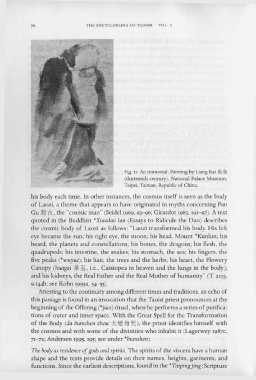Page 116 - The Encyclopedia of Taoism v1_A-L
P. 116
THE ENCYCLOPEDIA OF TAO ISM VOL. T
Fig. n. An immortal. Painting by Liang Kai ~f1l'
(thirteenth century). National Palace Museum,
Taipei, Taiwan, Republic of China ..
his body each time. In other instances, the cosmos itself is seen as the body
of Laozi, a theme that appears to have originated in myths concerning Pan
Gu fi~, the "cosmic man" (Seidel 1969, 93-96; Girardot 1983,191-97). A text
quoted in the Buddhist *Xiaodao lun (Essays to Ridicule the Dao) describes
the cosmic body of Laozi as follows: "Laozi transformed his body. His left
eye became the sun; his right eye, the moon; his head, Mount *Kunlun; his
beard, the planets and constellations; his bones, the dragons; his flesh, the
quadrupeds; his intestine, the snakes; his stomach, the sea; his fingers, the
five peaks (*wuyue); his hair, the trees and the herbs; his heart, the Flowery
Canopy (huagai ~1!, i.e., Cassiopea in heaven and the lungs in the body);
and his kidneys, the Real Father and the Real Mother of humanity" (T. 2103,
9.144b; see Kohn 1995a, 54- 55).
Attesting to the continuity among different times and traditions, an echo of
this passage is found in an invocation that the Taoist priest pronounces at the
beginning of the Offering (*jiao) ritual, when he performs a series of purifica-
tions of outer and inner space. With the Great Spell for the Transformation
of the Body (da bianshen zhou 7:. ~5t JE), the priest identifies himself with
the cosmos and with some of the divinities who inhabit it (Lagerwey 1987C,
71-72; Andersen 1995, 195; see under *bianshen).
The body as residence of gods and spirits. The spirits of the viscera have a human
shape and the texts provide details on their names, heights, garments, and
functions. Since the earliest descriptions, found in the *Taipingjing (Scripture

